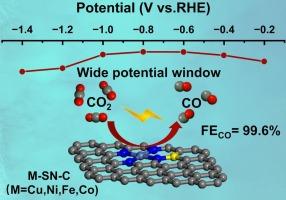在工业电流密度下M- n - c (M=Cu, Ni, Fe, Co)催化剂的s工程解锁超宽电位窗口
IF 6.9
2区 材料科学
Q2 CHEMISTRY, PHYSICAL
引用次数: 0
摘要
开发稳定、高效、宽电位窗、高电流密度的电化学二氧化碳还原(ECR)催化剂对于缓解能源燃料问题和保护生态环境至关重要。然而,随着潜在窗口的扩大,来自析氢反应(HER)的竞争加剧导致产品生成效率显著降低,从而限制了大规模工业应用的能源效率。本文在M- n - c的基础上,采用s -工程方法合成了一系列掺杂硫的过渡金属原子催化剂M- sn - c (M= Cu, Ni, Fe, Co),其性能得到了普遍提高。Ni-SN-C在−0.2 ~ -−1.4 V的超宽电位窗口下与可逆氢电极(RHE)相比,CO法拉第效率(FECO)超过90 %,在−0.8 V与RHE相比,最大FE达到99.6 %。此外,它在工业级电流密度下表现出稳定的性能,具有良好的工业规模应用潜力。利用原位分析和密度泛函理论(DFT)计算,研究了S原子影响材料ECR性能的机理。S原子的引入改变了速率决定步骤,显著降低了ECR的自由能势垒,促进了*COOH的形成以及随后*COOH向*CO的转化。这项工作为其实际工业应用提供了一个有希望的策略,并为杂原子掺杂过渡金属催化剂与ECR之间的结构-性能关系提供了新的见解。本文章由计算机程序翻译,如有差异,请以英文原文为准。


Unlocking ultrawide potential windows through S-engineering of M-N-C (M=Cu, Ni, Fe, Co) catalysts at industrial current densities in electrochemical CO2 reduction
The development of a stable and efficient electrochemical carbon dioxide reduction (ECR) catalyst with wide potential window and high current density is crucial for mitigating energy fuel issues and protecting the ecological environment. However, with the widening of the potential window, the increased competition from hydrogen evolution reaction (HER) leads to a significant decrease in product generation efficiency, thereby limiting the energy efficiency for large-scale industrial applications. Herein, a series of sulfur-doped transition metal atomic catalysts M-SN-C (M= Cu, Ni, Fe, Co) have been synthesized by S-engineering on the basis of M-N-C, which generally enhanced their performance. The CO Faraday efficiency (FECO) of Ni-SN-C at a ultrawide potential window of −0.2 to −1.4 V vs. reversible hydrogen electrode (RHE) exceeds 90 % and the maximum FE achieves 99.6 % at −0.8 V vs. RHE. Moreover, it demonstrates stable performance at industrial-level current density and holds promising potential for industrial-scale application. The mechanism of S atom affecting the ECR performance of materials is investigated using in-situ analysis and also supported by the density functional theory (DFT) calculations. The introduction of S atom changes the rate determining step and significantly reduces the free energy barrier of ECR, facilitating the formation of *COOH and the subsequent transformation of *COOH into *CO. This work provides a promising strategy for its practical industrial application and insights into the structure-performance relationship between heteroatom-doped transition metal catalysts and ECR.
求助全文
通过发布文献求助,成功后即可免费获取论文全文。
去求助
来源期刊

Applied Surface Science
工程技术-材料科学:膜
CiteScore
12.50
自引率
7.50%
发文量
3393
审稿时长
67 days
期刊介绍:
Applied Surface Science covers topics contributing to a better understanding of surfaces, interfaces, nanostructures and their applications. The journal is concerned with scientific research on the atomic and molecular level of material properties determined with specific surface analytical techniques and/or computational methods, as well as the processing of such structures.
 求助内容:
求助内容: 应助结果提醒方式:
应助结果提醒方式:


